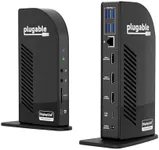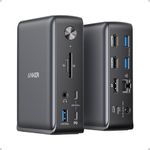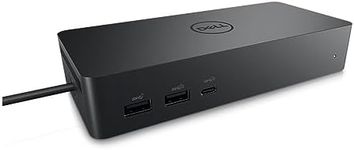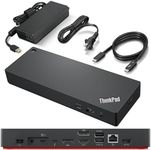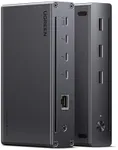Buying Guide for the Best Universal Docking Station
Choosing the right universal docking station can greatly enhance your productivity by allowing you to connect multiple devices to your laptop or desktop with ease. A docking station can provide additional ports, charging capabilities, and even improve your workspace organization. To find the best fit for your needs, consider the following key specifications and how they align with your usage requirements.Port AvailabilityPort availability refers to the number and types of ports that the docking station offers. This is important because it determines what devices you can connect to your docking station. Common ports include USB-A, USB-C, HDMI, DisplayPort, Ethernet, and audio jacks. If you have multiple peripherals like a mouse, keyboard, external hard drive, and monitors, you'll need a docking station with a variety of ports. For basic use, a docking station with a few USB ports and an HDMI port might suffice. For more advanced setups, look for stations with multiple display outputs and additional USB-C ports.
Power DeliveryPower delivery (PD) refers to the docking station's ability to charge your laptop or other devices while they are connected. This is crucial if you want to avoid using multiple chargers and keep your workspace tidy. Power delivery is measured in watts (W). For light use, a docking station with 60W PD might be enough. However, for more power-hungry laptops, you might need a docking station that offers 85W or more. Consider your device's power requirements to ensure the docking station can adequately charge it.
Display SupportDisplay support indicates the docking station's capability to connect to external monitors and the maximum resolution it can handle. This is important for users who need multiple screens for multitasking or high-resolution displays for detailed work. Docking stations can support different numbers of monitors and resolutions, such as 1080p, 1440p, or 4K. If you need a single external monitor, a docking station with one HDMI or DisplayPort output might be sufficient. For dual or triple monitor setups, look for docking stations that support multiple high-resolution outputs.
CompatibilityCompatibility refers to whether the docking station works with your specific laptop or desktop. This is crucial because not all docking stations are universally compatible. Some are designed for specific operating systems like Windows or macOS, while others are more versatile. Check the docking station's compatibility with your device's operating system and connection ports. If you use a MacBook, ensure the docking station supports macOS. For Windows laptops, verify that the docking station is compatible with your version of Windows.
Build Quality and DesignBuild quality and design refer to the physical construction and aesthetic of the docking station. This is important for durability and how well it fits into your workspace. A well-built docking station made from high-quality materials will last longer and withstand daily use. Additionally, consider the design and size of the docking station. If you have limited desk space, a compact and sleek design might be more suitable. For a more permanent setup, a larger docking station with a robust build might be preferable.
Additional FeaturesAdditional features include any extra functionalities that the docking station offers, such as SD card readers, built-in speakers, or security locks. These features can enhance your overall experience and provide added convenience. For example, if you frequently transfer photos from a camera, an SD card reader can be very useful. If security is a concern, look for docking stations with Kensington lock slots. Consider what additional features would be beneficial for your specific needs and choose a docking station that includes them.


